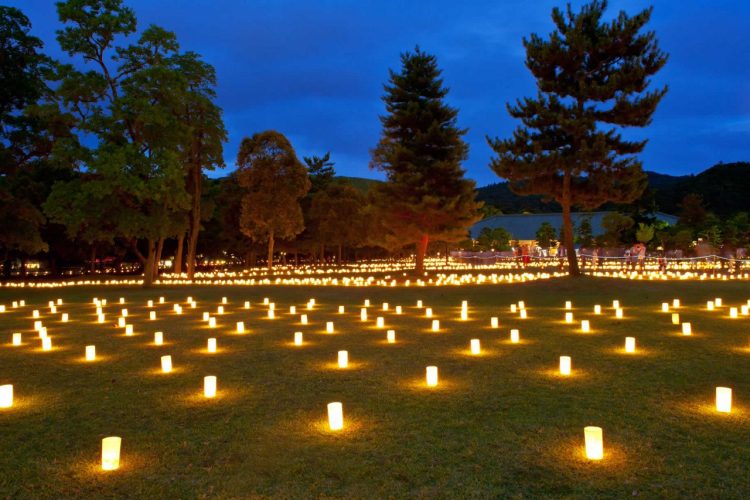Cultural and Religious Significance of Obon in Japan
Obon, also known simply as Bon, is one of Japan’s most important and deeply rooted festivals. It is celebrated to honor the spirits of ancestors and is a time for families to come together and pay respects to their deceased loved ones. The festival’s origins can be traced back over 1,500 years to Buddhist traditions, particularly the story of Mokuren, a disciple of the Buddha who sought to free the spirits of his ancestors from suffering. His prayers and offerings, according to the legend, were answered by the Buddha, leading to the practice of honoring ancestors during Obon.
In its modern form, Obon is celebrated during the middle of August (usually around the 13th to 16th), though the exact dates can vary depending on the region and local customs. Obon is not just a religious festival; it is a time when families come together to commemorate their ancestors, reconnect with their heritage, and reflect on the cycle of life and death. For many Japanese people, Obon represents a blend of Buddhist teachings, Shinto beliefs, and traditional practices that have been passed down through generations.
The central theme of Obon is the belief that during the festival, the spirits of ancestors return to their families’ homes to be reunited with the living. It is seen as a time of both mourning and celebration, where the living honor their ancestors by performing various rituals and offering food, incense, and prayers. These acts of devotion help ensure that the spirits are at peace and will be able to safely return to the afterlife after the festival.
While Obon is primarily a religious observance, it is also a time for families to come together, share meals, and enjoy festivities. The festival is a rich combination of cultural practices, including the lighting of lanterns, traditional dances, and offerings at temples and family altars. For many people in Japan, Obon is a deeply emotional and spiritual time that brings both a sense of reverence for the past and an appreciation for the continuity of life.
Best Places to Visit for Obon Celebrations: Kyoto, Tokyo, and Okinawa
Though Obon is celebrated across Japan, there are certain places that offer especially rich and vibrant experiences for those wishing to witness the festival’s rituals and traditions firsthand. Kyoto, Tokyo, and Okinawa each offer unique perspectives on Obon, with distinct local customs, regional variations, and ways to honor the spirits of ancestors.
- Kyoto
Kyoto, once the capital of Japan and home to numerous Buddhist temples and shrines, is one of the most atmospheric places to experience Obon. The city’s rich cultural heritage is amplified during the Obon season, with many local events and traditions that take place throughout the city. Kyoto’s temples and shrines hold special ceremonies during Obon, and the peaceful surroundings make it an ideal location for reflection and spiritual connection.
One of the most famous Obon traditions in Kyoto is the Gozan no Okuribi (also known as the “Daimonji Bonfire”). This tradition involves the lighting of large bonfires on the five mountains surrounding Kyoto, forming large characters and symbols such as “大” (which means “great” or “big”) to guide the spirits of the deceased back to the afterlife. The sight of these bonfires, visible from across the city, is both awe-inspiring and deeply emotional. The event takes place on August 16th, marking the end of Obon.
Another notable event in Kyoto is the Obon Odori, a traditional Bon dance held in many locations, where participants come together to dance around a central platform to honor the spirits. The dances vary from region to region, but in Kyoto, the dances are particularly elegant, and the vibrant yukata (summer kimonos) and taiko drum performances add to the festive atmosphere. Visitors to Kyoto during Obon can also explore the beautiful temples and shrines that host rituals such as offering food and incense to the spirits.
- Tokyo
Tokyo, the bustling capital of Japan, offers a more modern and urban perspective on Obon. While Tokyo may not have the tranquil mountain vistas of Kyoto, it is home to numerous cultural venues, temples, and shrines where Obon rituals are observed. The city’s sheer size and the diversity of people from various regions of Japan make Tokyo an interesting place to witness the fusion of traditional and contemporary Obon practices.
In Tokyo, visitors can attend Obon Odori dances in places like Koenji and Asakusa, where neighborhood communities come together to celebrate in the streets. These dances are colorful and lively, with participants in yukata joining hands and moving in a circle, honoring the spirits in a joyful, communal way. Asakusa, with its famous Senso-ji Temple, holds particularly significant Obon observances, where visitors can participate in prayers and light incense for their ancestors.
Tokyo’s Zojo-ji Temple, located near Tokyo Tower, is another excellent place to experience the solemn rituals of Obon. During the festival, the temple holds ceremonies where people can pray for the souls of their ancestors, and offerings of flowers, food, and incense are made to honor the spirits. The peaceful environment of the temple juxtaposed with the high-energy city makes it an intriguing place for visitors who want to experience the spiritual side of Obon in a modern setting.
- Okinawa
Okinawa, Japan’s southernmost islands, offers a distinctly different Obon experience. The Okinawan version of Obon, known as Eisa, is heavily influenced by local customs and unique cultural practices. Unlike the rest of Japan, Okinawa follows a different calendar for Obon, usually celebrating it in July rather than August, but the core principles remain the same: honoring the spirits of ancestors and inviting them back to the family home.
Eisa, the traditional dance of Okinawa, is a major feature of Obon celebrations here. This energetic and rhythmic dance is performed by large groups of people, often accompanied by drums and flutes. The colorful costumes and lively beats create a festive atmosphere, yet the dance is performed in reverence for the spirits. The celebrations are marked by both joyous community participation and a solemn recognition of the deceased.
In Okinawa, families often set up altars in their homes to welcome the spirits of their ancestors, offering food, incense, and prayers. The Shurijo Castle in Naha, the capital of Okinawa, is an important site during Obon where visitors can learn about the history and significance of the island’s unique customs. The island’s beautiful coastal views and slower pace of life offer a peaceful and introspective way to experience the Obon rituals in their most authentic form.

Rituals like Bon Odori Dance and Lantern Lighting
One of the most important and symbolic aspects of Obon is the performance of the Bon Odori, a traditional dance that is performed throughout Japan during the festival. The dance varies from region to region, but its primary purpose is to welcome the spirits of ancestors back into the community. Participants typically wear yukata, the casual summer kimono, and dance around a raised platform known as the Yagura.
The movements of the Bon Odori are simple but rhythmic, and they often represent the journey of the spirits as they return home. In many regions, the dance is accompanied by traditional music played on drums, flutes, and shamisen, creating an atmosphere of joy and unity. The dances are usually performed in public spaces, such as parks and temples, where communities gather to celebrate together.
Another significant ritual during Obon is the lighting of lanterns to guide the spirits of the ancestors back to their resting places. Lanterns are placed at the family home, temples, and along rivers, illuminating the night with soft, flickering light. The lanterns are meant to symbolize the souls of the ancestors returning home and offer them guidance as they make their way back to the spiritual realm. In some regions, families will float lanterns on rivers or the sea, creating beautiful visual displays of remembrance.
The Toro Nagashi (lantern floating) ceremony is a particularly moving tradition in which paper lanterns are set adrift on rivers, symbolizing the release of the spirits back into the afterlife. This ceremony is often held on the final night of Obon, and the sight of hundreds of floating lanterns is a poignant reminder of the fleeting nature of life.
The Role of Obon in Honoring Ancestors
At its core, Obon is a festival dedicated to honoring and remembering deceased ancestors. In Japan, family and lineage are highly valued, and the act of paying respect to the spirits is seen as a way to maintain familial bonds and ensure that the spirits are at peace. Obon serves as a reminder of the interconnectedness of life and death, emphasizing the cyclical nature of existence.
The rituals of Obon are meant to bring comfort to the living as well as the deceased. By offering food, incense, and prayers, families express their gratitude and affection for their ancestors while also seeking blessings for prosperity and protection. It is common for families to gather during Obon, clean the family grave, and offer food at altars, creating a time for reflection and togetherness.
Obon is also a time for the Japanese people to express their connection to nature and the universe. The belief that the spirits of ancestors return home during Obon underscores the cyclical nature of existence and reinforces the idea that life and death are interconnected. Through these rituals, families and communities maintain a strong spiritual connection with their past, ensuring that the memory of their ancestors is preserved for future generations.
Travel Tips for Attending Obon Festivals and Rituals
If you’re planning to visit Japan during Obon, here are some helpful tips to ensure you have an enriching and respectful experience:
- Understand the Cultural Significance
Obon is an important cultural and religious event in Japan, so it’s essential to approach it with respect. Be mindful of the spiritual significance of the rituals and remember that this is a time for families to mourn and honor their ancestors. - Participate in Bon Odori Dance
Joining in the Bon Odori dance is a great way to experience the festival and connect with the local community. Don’t be shy—locals are often happy to welcome visitors to participate in the dance, and it’s a fun and interactive way to immerse yourself in the festival’s spirit. - Attend the Lantern Floating Ceremony
If you’re in Japan towards the end of Obon, try to attend a lantern floating ceremony, such as Toro Nagashi, which is a deeply moving and beautiful experience. The sight of lanterns drifting on rivers or the sea is symbolic of the peaceful return of the spirits to the afterlife. - Explore Regional Customs
Obon celebrations vary across Japan, so make sure to explore different regions and experience their unique traditions. Whether it’s the bonfires of Kyoto, the Eisa dances in Okinawa, or the urban Obon events in Tokyo, each place offers a distinct perspective on this spiritual festival. - Plan for Crowds
Obon is a major holiday in Japan, and many people travel to visit family or participate in local events. Be prepared for crowded transportation and public spaces, especially in major cities like Kyoto and Tokyo. Plan ahead and book accommodations early to avoid last-minute hassles.
Conclusion
Obon is a beautiful and deeply spiritual festival that offers insight into Japan’s cultural and religious heritage. Whether you’re participating in the Bon Odori dance, lighting lanterns to guide the spirits of ancestors, or reflecting on the sacred connection between life and death, Obon is a unique experience that will leave a lasting impression. By visiting Kyoto, Tokyo, Okinawa, or any of Japan’s other regions during Obon, you can witness the blend of ancient traditions and contemporary customs that make this festival so special.





















